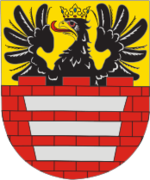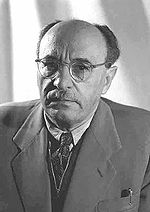- Mir, Belarus
-
Mir is an urban settlement in Kareličy (Карэлічы) raion, Hrodna Voblast, Belarus (53°27′N 26°28′E / 53.45°N 26.467°E) on the banks of Miranka River, about 85 kilometers southwest of the national capital, Minsk.
Mir village was founded sometime prior to 1345. It is home to a late medieval castle, which made the town the target of many attacks over the centuries. The town belonged to the Illinicz family (Korczak coat of arms) first and then to the Radziwiłł family. It was destroyed by the Swedish forces in 1655 (Deluge)and again by the Swedes during the Great Northern War in 1706. In 1792 the Lithuanian division of the Polish-Lithuanian Commonwealth army under Józef Judycki was routed by the invading Imperial Russian army corps under Boris Mellin (see Battle of Mir). During the Napoleonic invasion of Russia in 1812, Russian Imperial cavalry, artillery and cossack regiments ambushed and routed the Duchy of Warsaw 3 uhlan divisions (Battle of Mir (1812)). The retreating Russians, withdrawing east, abandoned the town and dynamited the castle. During the Middle Ages it was first located in the Principality of Polotsk, after the Battle on the river Nemiga in the Principality of Minsk, then was taken over by Kievan Rus' but after the Mongol Invasion the Rus' rule diminished and since 1242 Mir belonged to the expanding and dynamic Duchy of Lithuania. In 1569 it became a part of the Polish-Lithuanian Commonwealth. From 1793 it was part of the Russian Empire (Partitions of Poland), then returned to Poland in 1920, before being occupied by the Soviet Union in September of 1939. From 1941 through 1944, Mir was occupied by Nazi Germany, then again by the Soviet Union until 1991, when it became part of independent Belarus.
Mir was the site of two very famous horse fairs associated with Saint Nikolaus feast days, first held on May 9 and the second fair on December 6 each year. Both fairs lasted four weeks each and were very popular and well known throughout the country until 1939. Roma practically dominated the fairs as horse traders, and numerous Roma community thrived in the town until 1939. The fairs collapsed in 1941, when Nazi Germany invaded the Belorussian Soviet Republic and murdered the Roma people of Mir. Mir's claim to fame in Jewish Diaspora history is that it was the original home of the Mir yeshiva which operated there intermittently from 1815 until the fall of Poland in 1939, when the invading communist Soviet Red Army and security forces pressured the school to close and relocate to then still free Lithuania. (Current incarnations of the yeshiva are located in Brooklyn, New York and Jerusalem.)
Today Mir has little industry and is no longer an internationally renowned center of Jewish learning or Roma horse trade. Home to about 2,500 people today, virtually none of whom are descended from the once thriving Jewish and Roma communities, its primary attraction is the Mir Castle as well as memorials erected by the Soviet government and various Jewish groups over the past half century.
Notable residents
- Zalman Shazar (1889–1974), Israeli author, poet, and third President of Israel from 1963 to 1973
See also
External links
- The Jewish Community in Mir, an online exhibition by Yad Vashem
- Photos on Radzima.org
- Reeva Kimble's Mir site
Categories:- Urban-type settlements in Belarus
- Hrodna Voblast
- Historic Jewish communities
Wikimedia Foundation. 2010.



